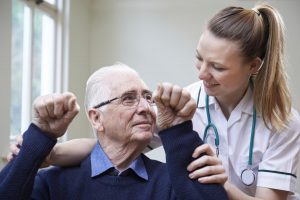Now is a Time of Great Progress for Parkinson’s Disease

This is a time of great progress in the diagnosis and treatment of Parkinson’s. Both major and minor technological advances add together to paint a brighter future for understanding and treating it. One area is several breakthroughs toward the ability to diagnose it earlier, allowing early treatment to slow its progression. Targeted, personalized treatment are in development, moved forward by brain imaging techniques like positron emission tomography (PET scans) and magnetic resonance imaging (MRI). Higher resolution scans can aid in pinpointing those brain areas that are most affected as the places to focus treatment. New treatments are planned, such as stem cell transplants and immunotherapies. Immunotherapies would use antibodies that are designed to seek out the relevant brain areas and slow or halt Parkinson’s progression. There are refinements in bioelectric medicine, that is, deep brain stimulation, to stimulate or to inhibit identified brain circuits.
Welcome to the Neuroscience Research and Development Consultancy website. Have a question or a comment? Send it to us at: Comment@NeuroSciRandD.com
Articles related to Parkinson's Disease:
Parkinson’s – Slow, Progressive Neurodegeneration
Parkinson’s is a medical disorder, a brain-based movement disorder, with brain changes that affect how one moves, walks, stands, reaches for objects, and holds objects. It starts with minimal changes, as we describe below. Then gradually it progresses. An area deep in the brain, the basal ganglia, slowly loses nerve cells that make a signaling molecule called dopamine. As cells die and too little dopamine is made, the condition progresses. At first it affects mainly muscle movement that is seen as stiffness, rigidity, tremor, slowed movement, and difficulty with walking. Later it affects one’s mood, sleep, and thinking ability, and eventually it progresses to dementia.

The First Signs of Parkinson’s
In 1817 a London physician, James Parkinson, wrote “An Essay on the Shaking Palsy.” But that wasn’t really the beginning. Physicians had known about this medical condition for several thousand years. And during these millennia the disorder remains the same. The first change people feel is a bit of a tremor, a mild shakiness, usually of one hand. Or, the shakiness might be in an arm or a leg. In the hand, the Parkinson’s tremor is called a “tremor at rest”. The hand only shakes when it’s relaxed. The shaking stops if the person uses his hand. When his hand is once again resting and relaxed, the tremor comes back. The hand tremor is sometimes called a “pill-rolling” tremor because when the hand is relaxed the thumb and forefinger move as though the person is rolling a pill between them.
One of our readers in Newark, New Jersey (USA) commented:
If you’re taking care of a spouse with Parkinson’s you have to get into some sort of Parkinson’s caregivers support group. I was having all kinds of problems with my husband and it was because I was doing everything wrong. After I got into a group and learned how to do things right it got much better. He’s gone now, God rest his soul, and it was tough. It was awful. But it would have been much worse if I hadn’t learned the right things to do.
This is good advice. There are so many approaches to caring for someone with Parkinson’s and learning and pursuing the better ways of doing it can make a huge difference. Like, yes, go to their doctor visits with them, and yes, track their medication to make sure they’re taking it. Don’t keep changing their schedule day-to-day, keep it consistent. Some people keep planning new things for fear that the person with Parkinson’s will get bored. Not so. Schedule changes disorient them. There are dozens of these tips and participating in a Parkinson’s caregivers support group can teach one a lot.
Beyond That Early Parkinson’s Tremor
Gradually the situation changes. The way a person steps while walking changes. His posture when he is standing still is different, too. It’s a stooped posture. The way his face looks changes because his face muscles move less.
The Easily Recognized Parkinsonian Gait – How He Walks
As Parkinson’s progresses, a person’s walk changes. It can change in a few different ways. One is called a “shuffling gait”, where he seems to drag his feet when he walks, taking smaller steps and not swinging his arms much. Another type of walking is the “freezing gait”, where he starts to take a step but then stops. It’s like his foot is stuck to the floor. After a step or two he walks more normally. Finally, there’s the “festinating gait”, taking quick, short little steps. (Festinate means to hurry.) But it’s a slow walk because, though the steps are quick, they’re so small, there’s not much progress across the room.

Parkinson’s Posture – How He Stands
Maybe the best word to describe the way a person with Parkinson’s stands is “stooped”. The brain doesn’t send the right “stand up straight” signals. The result is rounded shoulders with his head and upper body leaning forward. The stiff muscles that come with Parkinson’s don’t help the situation. (Good news: Physical therapy can help a person overcome Parkinson’s posture. You can read more about it on our Parkinson’s Treatment page.)
The Frozen Face of Parkinson’s
It’s the stiff muscles problem again. With Parkinson’s a person’s face muscles are less able to move to show emotions on his face. It becomes hard to smile or frown. It’s as though he’s wearing a mask of his own face, and it’s called “facial masking”. Without smiling, frowning, or other facial expressions of emotion it makes it look as though he doesn’t have any emotions.
What Happens and How Fast It Gets Worse is Unpredictable
What happens, when it happens, and how quickly things get worse is different for each person. Your personal physician doesn’t have the ability to predict what will happen next and how fast everything will move along. Some people are lucky in that they have only minor signs like a bit of a tremor. The right medications at the right time, regular exercise, and physical and occupational therapy can slow it down. However, it’s important to understand that It’s an ongoing condition that can be treated but cannot be cured. Sadly, there’s just no way to completely stop it. Not yet. Once Parkinson’s starts it continues for the rest of the person’s life. And it does gradually change over time, continually even if slowly getting worse.
The 5 Stages of Parkinson’s
As time goes by more signs appear. His arms don’t swing in quite the same relaxed way when he walks. His voice gets quieter. The changes over time are consistent enough that physicians have been able to divide them into 5 stages.
Stage 1 of Parkinson’s – No Problems
In this earliest Stage 1 of Parkinson’s the movements are only altered on one side of the body. The symptoms are mild and the person can do anything he wants to do. He can move as he needs for tasks and jobs, hobbies and sports. Often at this stage he doesn’t even realize a medical problem has started. And if he did, the signs are so minimal that his physician might not be able to make the right diagnosis. No physician would to guess wrong and have the patient feel that he has Parkinson’s if that’s not what’s wrong. There might be a bit of a tremor now and then in one hand. Or just a bit of not-quite-right feeling or movement in an arm or a leg. He might feel his muscles are just a bit stiff.

Stage 2 of Parkinson’s – The First Hints of Things to Come
Months, or even years, after Stage 1 has appeared, the person might start having the signs of Stage 2. This second stage is still mild Parkinson’s but it’s more noticeable. In Stage 2 his physician might be able to make the diagnosis, especially if there’s a tremor. Both sides of his body might be involved. There might not be any difficulties with balance but his trunk muscles might feel stiff. There might be neck or back pain with a start of the stooped posture of Parkinson’s. It’s in Stage 2 that the changes in his face might start, with his face appearing stiff, with less blinking. His voice might get softer, quieter, as he talks, and what he says might be slurred at times. While all his movements are slowed he can still get everything done, all the usual tasks of daily life.
More on Stages 1 & 2 – Parkinson’s Signs You Don’t See
In addition to the changes you can see in these early stages there are changes with the individual that you can’t see. For example, he might lose some or all of his sense of smell. His thinking might slow down. He might have been quick-minded before Parkinson’s, but no longer. Though previously a strong person, he might start to feel physically weak. He used to be a vigorous, robust individual but now he starts to feel just a bit sick all the time. Life might slowly drift toward being a burden, with no fun at all, which then could slide into a depression.

Stage 3 of Parkinson’s – Here Comes Trouble
Stage 3 is when the diagnosis becomes clear and the feeling of disability really starts. The individual can still do everything even though disability is starting. He can do all the tasks of daily living like taking showers, brushing his teeth, getting dressed, and eating. So, in Stage 3 the individual can still live alone. However, at this point all the signs of Parkinson’s are there. A physician can make the diagnosis without a doubt. His movements are obviously slowed and there are problems with keeping his balance. The balance problem is there because, without knowing it or thinking about it, we all keep our balance with little muscle and position changes all the time, moment to moment. As Parkinson’s gets worse these little balance fixes are slower or not there at all. Because of this, falling is more common.
Stage 4 of Parkinson’s- Trouble Is Here
Stage 4 is when the real difficult times start. He can no longer live independently by himself. For some of those tasks of daily living, like bathing, dressing, and eating, he needs someone’s help. This need for help is what marks him as in Stage 4. The Parkinson’s disease has become really disabling. Even if he can stand by himself and walk along alone it’s clearly a struggle. A walker can help.

Stage 5 of Parkinson’s – Some Never Make It This Far
Stage 5 is the worst. In fact, some people never make it to Stage 5. In Stage 5 he can’t stand up from a chair or get out of bed by himself. He might fall just with standing. Even when walking with a walker he might freeze in place or stumble as he tries to walk. As you can imagine, at this point he needs seven days a week, twenty-four hours a day, around-the-clock assistance so that he doesn’t fall and to help him eat, bathe, and dress. He might even start to test reality poorly, having hallucinations (seeing or hearing what’s not there) and delusions (believing something that’s just not true).
Parkinson’s Disease is a Really Common Condition
It’s heartbreaking to say, but in truth Parkinson’s is a really common medical condition. It’s so common that each of us probably knows someone who had it or has it now. Worldwide, it’s one of the most common disorders of the nervous system. About 1 out of every 100 people over age 60 will eventually get it.
Younger People, Under Age 50, Can Get Parkinson’s
Parkinson’s is usually viewed as a condition of the elderly. And while this is true for the most part, younger individuals can get it. For every 20 people who have Parkinson’s it’s likely that one will be under age 50. To put it another way, about 5% of people with Parkinson’s had it start before age 50.
The Intense International Push for Research on Parkinson’s Treatments and Cures
The major worldwide effort is in progress. People with Parkinson’s (including some well-known celebrities like Michael J. Fox, Linda Ronstadt, and Alan Alda), their families, and the physicians who treat them are all pushing public opinion to support more research on Parkinson’s. Everyone wants answers. And a lot of public interest helps drive fund raising for research and patient care. The research is across many areas, like the types of exercise one can do to slow it so that it progresses much more slowly. Drug companies and universities search for new medications. Medical technology companies are working to invent new non-drug devices and treatments. To help speed research along, genetically-modified animals have been made that behave physiologically as people do when they have Parkinson’s. The animals allow researchers to test trial medicines to see if they are safe and might help people.
Helpful links:
Clinical Trials for Parkinson’s Treatments – CllinicalTrials.gov
Parkinson’s Information Page – National Institutes of Health
More on Parkinson’s – National Institute on Aging
Parkinson’s – MedlinePlus – U.S. National Library of Medicine
Understanding Parkinson’s – Parkinson’s Foundation
About Parkinson’s – The Michael J. Fox Foundation
Parkinson’s – The Mayo Clinic
